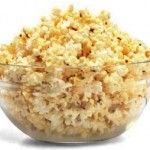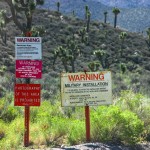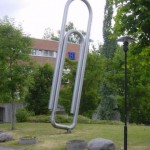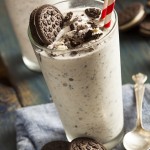Weekly Wrap Volume 71
First a little background, Popcorn or “zea mays everta” is a special kind of Flint corn, also known as “Indian corn” and sometimes “Calico corn”. Flint corn is readily recognizable as the kernels have a hard outer shell, likened to flint, hence the name. This hard outer shell is essential in making popcorn kernels pop. In fact, popcorn is the only type of corn that will pop. So why does popcorn pop? There are three main elements of popcorn that have to come together to produce popcorn kernels that are good for popping. Those… (more)
Despite the CIA’s release of previously classified documents in 2013 that acknowledged the existence of Area 51 as a top-secret U.S. government research facility, many questions about the site remain unanswered. One of the most innocuous, but nonetheless puzzling, is its choice of name. Although theories abound, one plausible explanation is that the moniker derives from its designation as a nuclear weapons testing site. Situated in the desert in southern Nevada, within the boundaries of the Nellis Air Force Range (NAFR) and just outside of the northeast corner of the Nevada Test Site (NTS), Area 51 and its neighbors, which also includes the… (more)
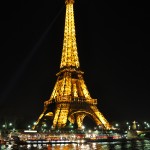 The Man Who Sold the Eiffel Tower
The Man Who Sold the Eiffel Tower
It was in May of 1925 when Victor Lustig first conceived the scheme that would make him a legend. With documents and letterheads proclaiming him the Deputy Director of the Ministere de Postes et Telegraphes (the Ministry of Postal Services and Telecommunications), Lustig had sent out notes to prominent Paris scrap metal businesses urgently asking them to meet him at the Hotel de Crillon. Six dealers came, curious what the French government wanted with them. After an expensive meal and plenty of wine, Lustig declared, in his typical charismatic fashion, that the city of Paris was going to knock down the Eiffel Tower and sell it for scrap metal. This was a huge secret and the public could not know at this point, of course, but he wanted the scrap metal businesses to bid against one another to see who would get this extremely valuable government contract. Negotiations began in earnest with Andre Poisson winning the bid for seventy thousand dollars (about a million dollars today). It was a lot of money, but to Poisson, who was new in town and wanted to establish a reputation, it was worth the huge contract. Of course… (more)
One very popular false origin of the paperclip was that it was invented by Norwegian patent office manager, Johan Vaaler. He was even granted patents in Germany and the U.S. for a paperclip of similar design as the Gem style paperclip, which is the most commonly used paperclip today, but which came after the Gem paperclip was already popular throughout Europe. His design was slightly different than the Gem paperclip in that it didn’t include the all too critical second loop that makes the Gem style much more functional. His paperclip had the papers inserted by lifting the outer wire slightly and pushing the papers into the clip such that the rest of the clip stood out from the paper at a 90 degree angle, which was necessary because of the lack of the critical second loop to allow the papers to be more or less embedded in the clip flatly. This also made it so the papers wouldn’t be held together very well as they relied only on how bendable the wire used was to hold the papers. The Gem style paperclip, on the other hand… (more)
 What the Things You See When You Rub Your Eyes Are Called
What the Things You See When You Rub Your Eyes Are Called
A phosphene is characterized by perceiving some form of light when there is little or no light actually entering the eye, making it an entopic phenomenon (meaning the source of the phenomenon is within the eye itself). Phosphenes are most commonly introduced by simply closing your eyes and rubbing them or squeezing them shut, tightly; generally the harder you rub or squeeze, the more phosphenes you’ll see. This pressure stimulates the cells of the retina and, thus, makes your brain think you are seeing light. Specifically, Grüsser et al. demonstrated that pressure in the eye results in activation of retinal ganglion cells in a very similar way to how they activate as a response to light. There are also… (more)
Bonus Quick Facts:
- The term “Speak of the Devil” is the shortened version of “Speak of the Devil and he doth appear. ” It was first printed in Giovanni Torriano’s ‘Piazza Universale’ in 1666 where he wrote, “The English say, Talk of the Devil, and he’s presently at your elbow.” In 1672, it again appeared in a poem which stated “Talk of the Devil, and see his horns.” However, during the 19th century the term started losing its sinister meaning and was used as a warning of an eavesdropper to a conversation rather than the literal Devil. In the 20th century, it simply started being a reference to someone who appeared unexpectedly while being talked about.
- Popcorn saw its biggest surges in popularity during times of duress, particularly during the Great Depression and WWII. The former of which because popcorn was an extremely cheap snack, the latter thanks to sugar rations, which made candy much more expensive and hard to come by. During WWII alone, Americans began eating three times more popcorn than they had before the war. After the war, as more and more people started staying home and watching TV, rather than going to the movies, and sugary snacks were once again readily available and cheap, popcorn sales fell somewhat. However, within a decade they surpassed the WWII numbers thanks to a partnership between the Popcorn Institute, Coca-Cola, and Morton Salt, who heavily campaigned to convince people that popcorn and Coke made a great snack while watching TV. Yet another surge happened in the 1980s, thanks to the now ubiquitous microwave, as well as the commercial availability of shelf stable (doesn’t need refrigerated), flavored microwave popcorn, the first of which was ACT II.
- The popcorn machine was invented in 1885 by a confectionery shop owner, Charles Cretors. He purchased a peanut roasting machine for his shop, which didn’t work very well, so he redesigned it. His redesign allowed for not only roasting peanuts, but also evenly popping popcorn in seasoning. This was a far superior method of making popcorn over the classic wire-basket over an open flame with seasoning added after it was popped method. He then began selling this machine commercially and today the vast majority of professional poppers, including those at most movie theaters, are still made by the Cretors family via C. Cretors & Company.
- Ben and Jerry, creator of Ben & Jerry’s ice cream, first met in a Jr. High gym class at Merrick Avenue Middle School. The two were both lagging behind while running, which caused the gym teacher to yell at them and warned them that they’d have to run two miles if they didn’t pick it up. From there, the two became best friends, and the rest is history.
- Jimmy Stewart’s final film role was as the voice of Wylie Burp, in the 1991 movie An American Tail: Fievel Goes West.
- Camels have three eyelids. Two of the eyelids have eye lashes which help protect their eyes from sand. The third is a very thin lid which works as a sort of “windshield wiper” to clean off their eyes. It closes/opens from side to side rather than up and down. It is also thin enough that the Camels can see through it somewhat. So in a sandstorm or otherwise windy day where sand is being stirred up, they can close that lid to protect their eyes from the sand, but still see where they are going.
- The Italian town of Viganella gets no direct sunlight for about seven weeks each winter. In order to solve this problem, in 2006, a computer controlled mirror was installed which is approximately 25 feet by 15 feet. The mirror is controlled such that it reflects sunlight into the town’s main city square during the day time.
Other Interesting Stuff:
A common misconception is that yellow mustard (the kind you put on your hot dog) is yellow because of the mustard seed. This is not true. The mustard seed is a dullish gray, brown color. The striking, bold yellow color actually comes from the rootstock of a plant called turmeric. Turmeric, native to the rainy humid tropical forests of South Asia, has been used as a natural food dye for centuries. The turmeric plant is harvested annually for its rhizome, or rootstock. The rhizome is boiled, dried out, and ground into a powder. This powder is then mixed with mustard seed powder, vinegar, water, salt, and voila, you got yourself traditional yellow mustard! Turmeric is also a common ingredient in many South Asian and Indian dishes. It provides an earthy, slightly bitter… (more)
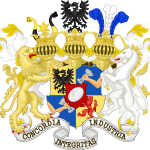 The Richest Family in the World
The Richest Family in the World
Who was the wealthiest person in every century? That was a question we tried to answer in a previous TIFO article. While it was an incredibly difficult question to get definitive answers to, it did reveal that the wealthiest private entity in the 19th century was actually not a person – but a family. The Rothschild family, descendants of Mayer A. Rothschild, is still around today and is believed to be worth over a trillion dollars combined, thought to be the largest private fortunate in the history of the world. Who are the Rothschilds exactly and how did they amass this tremendous fortune? Mayer Amschel Rothschild, the patriarch of the Rothschild fortune, was born in 1744 in a Jewish ghetto in Frankfurt, Germany. When his father passed away, Mayer was still young, but he took over the family’s currency-exchange business. The work required Mayer to know a lot… (more)
In 1890, a group of eight large New York City bakeries combined to form the New York Biscuit Company and built a giant six-story factory in West Chelsea. Eight years later, they merged with their competitor, Chicago’s American Biscuit and Manufacturing to form an even larger conglomerate – the National Biscuit Company, but the factory and headquarters remained in Chelsea. In 1901, the National Biscuit Company put their abbreviated company name on a box of wafers for the first time – Nabisco. Soon, Nabisco became the company’s official name. On April 2, 1912, the National Biscuit Company announced to their sales team that they were introducing three “highest class biscuits,” in a grouping they called the “Trio.” Two of the cookies, the Mother Goose Biscuit and Veronese… (more)
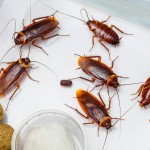 What Do Cockroaches Eat and Where Do They Live When There are No Houses Around?
What Do Cockroaches Eat and Where Do They Live When There are No Houses Around?
neaky and skittering, invasive and indomitable, the disgusting peridomestic cockroach is a formidable enemy for anyone unlucky enough to live among them. Interestingly, however, they are surprisingly delicate, and at least one species is utterly dependent on humans for its survival. Of the 5,000 known species of cockroaches, those that most plague people are the American cockroach (Periplaneta Americana) and the German cockroach (Blattella Germanica). Americana is the largest cockroach encountered in human constructions, growing to an average length of 1.5 inche… (more)
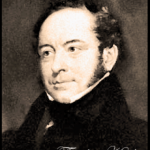 The Greatest Practical Joke of the 19th Century, the Berners Street Hoax
The Greatest Practical Joke of the 19th Century, the Berners Street Hoax
The year was 1809. Famed English author, Theodore Hook, made a bet with one of his close friends, the noted architect and writer, Samuel Beazley, that within one week, he could make any house in London the most talked about place in the city. The house he ended up choosing was the home of the widow Mrs. Tottenham on 54 Berners Street, London, which was the same street that Earl Stanhope and the Bishop of Carlisle and of Chester, among other wealthy and well-to-do individuals, lived on at that time. It isn’t known why Hook chose Mrs. Tottenham’s home as no connection between the two is known and Hook himself never explained his selection. It’s entirely possible that it just happened to be a location where the home across the street could be rented and was also in a fairly well-to-do… (more)
This Week’s Podcast Episodes:
- Podcast Episode #316: Buried in a Pringles Can
- Podcast Episode #317: The Tunguska Event
- Podcast Episode #318: The Paperclip
- Podcast Episode #319: An Epidemic
Quote of the Week:
- “Science is much more than a body of knowledge. It is a way of thinking. This is central to its success. Science invites us to let the facts in, even when they don’t conform to our preconceptions. It counsels us to carry alternative hypotheses in our heads and see which ones best match the facts. It urges on us a fine balance between no-holds-barred openness to new ideas, however heretical, and the most rigorous skeptical scrutiny of everything — new ideas and established wisdom. We need wide appreciation of this kind of thinking. It works. It’s an essential tool for a democracy in an age of change. Our task is not just to train more scientists but also to deepen public understanding of science.” -Carl Sagan
| Share the Knowledge! |
|

